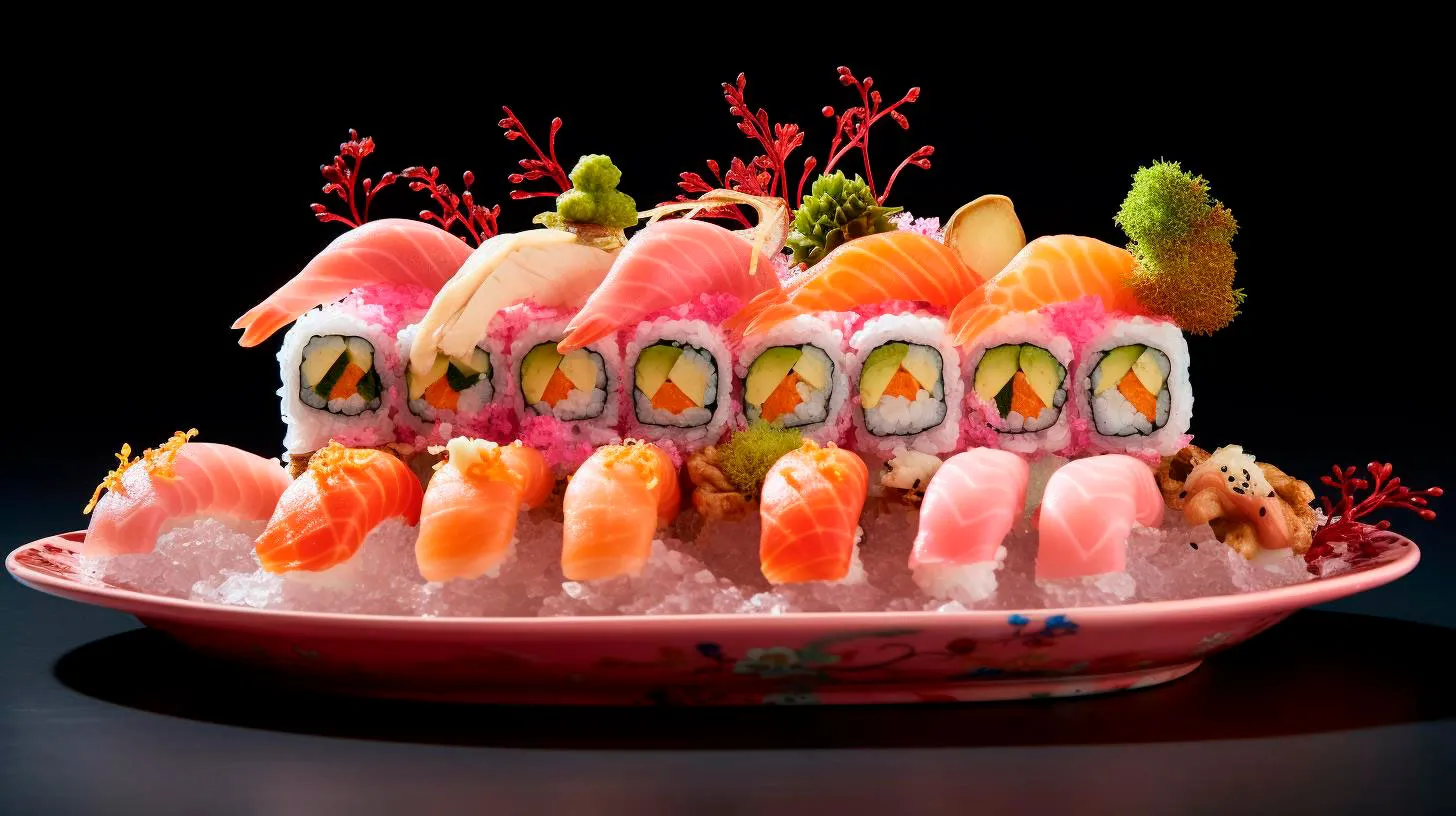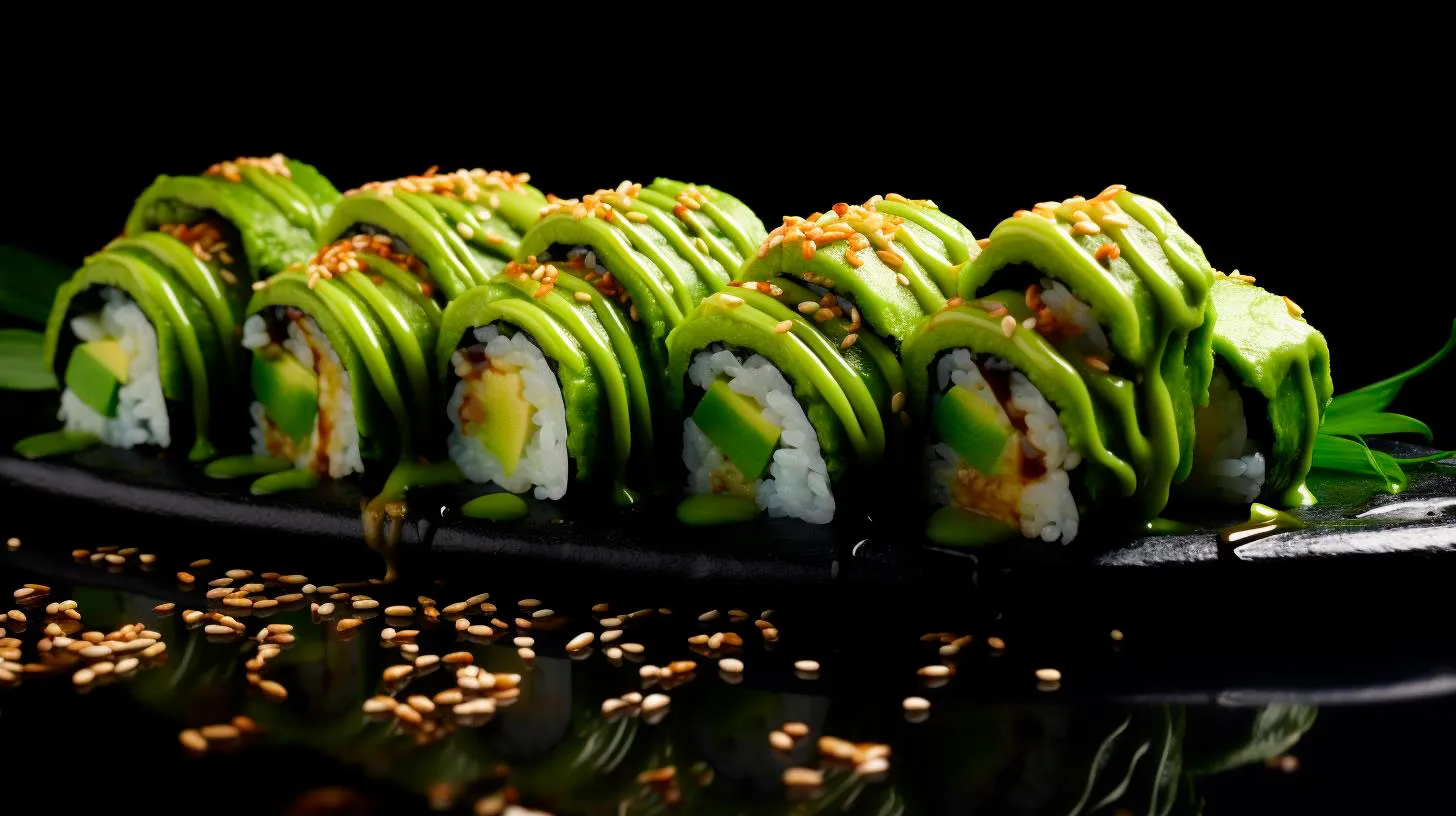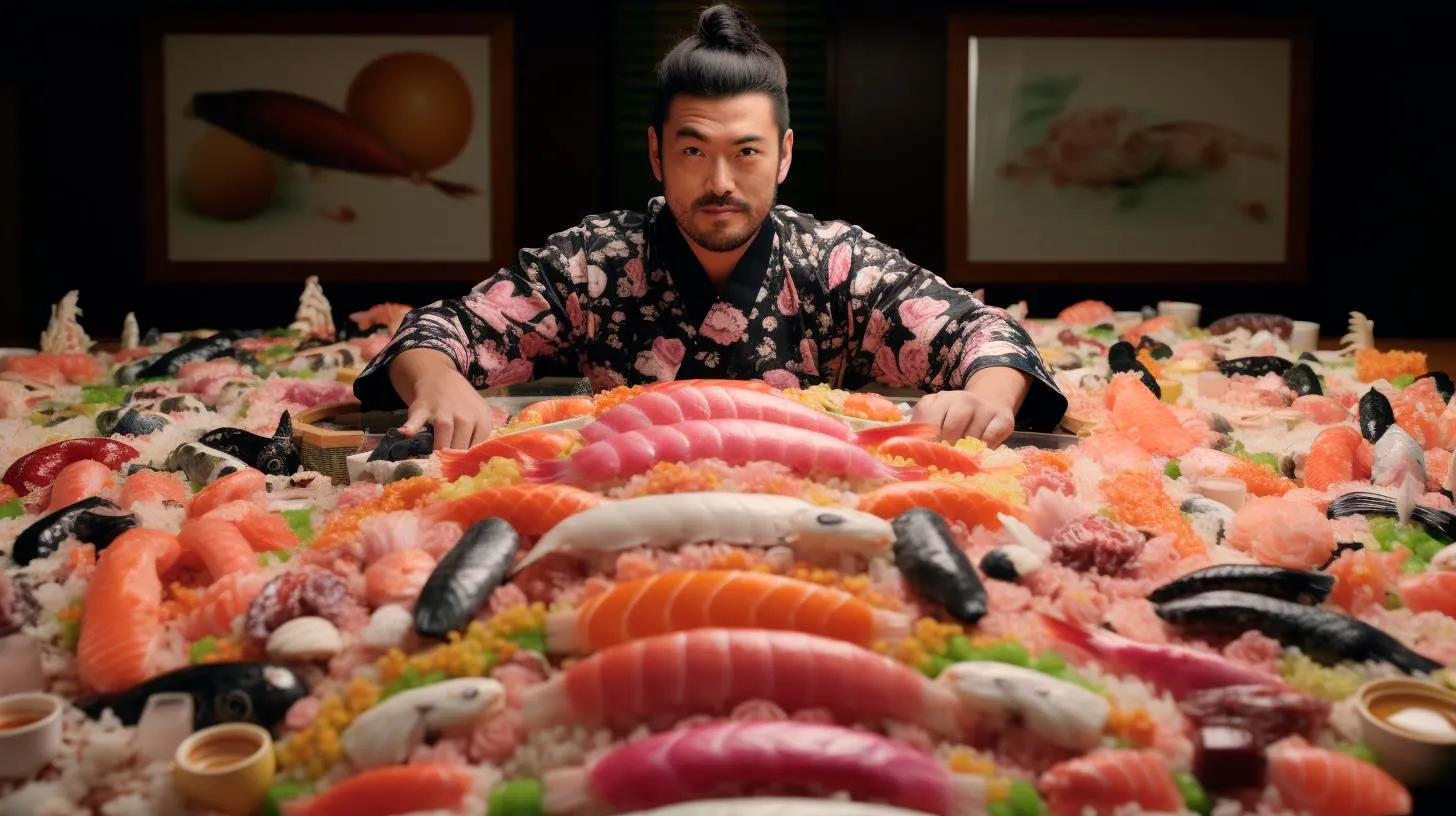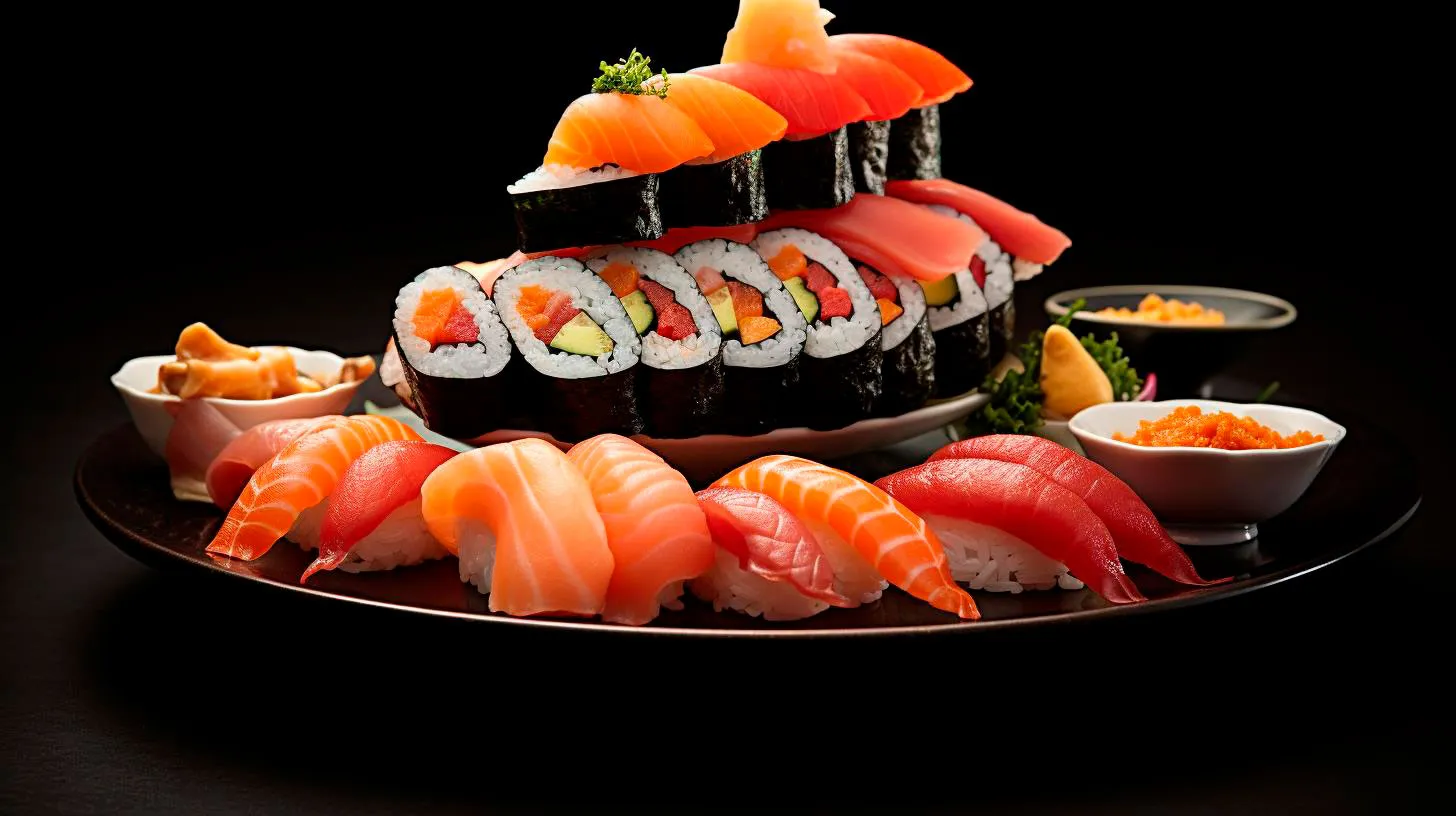Exploring the Versatility of Tobiko and Masago in Sushi
Two such ingredients are tobiko and masago.
Tobiko
Tobiko refers to the roe of flying fish, which adds a burst of flavor and color to sushi. These small, vibrant eggs come in a variety of colors, including orange, red, green, and black. Tobiko has a slightly sweet and briny taste, making it a desirable ingredient in sushi preparations. The vibrant colors of tobiko make sushi visually appealing, elevating its overall presentation. It is a versatile ingredient that can be used in various sushi rolls, nigiri, and even as a topping for other seafood dishes.
Some key features and advantages of using tobiko in sushi are:
- Texture: Tobiko has a unique texture, with each egg bursting deliciously in your mouth. It adds a delightful crunch to sushi, enhancing the overall eating experience.
- Flavor: The slightly sweet and briny flavor of tobiko complements the freshness of fish and the creaminess of sushi rice, making it an excellent addition to any sushi creation.
- Visual Appeal: The vibrant colors of tobiko make sushi visually appealing and can enhance the presentation of any sushi platter, making it a feast for the eyes as well as the taste buds.
Sushi chefs often use tobiko creatively to enhance their creations. It can be seasoned with soy sauce, wasabi, or other flavorings to add an extra kick. The versatility of tobiko makes it an integral part of sushi and a favorite among sushi enthusiasts worldwide.
Masago
Similar to tobiko, masago is also a type of roe commonly used in sushi. It comes from the capelin fish and is known for its bright orange color. Unlike tobiko, masago eggs are smaller and have a milder flavor. Masago is often used as a garnish in sushi rolls and also provides a unique texture when consumed.
Key takeaways about masago include:
- Enhances Flavor: While masago has a milder taste compared to tobiko, it still adds a subtle burst of umami to sushi, enhancing the overall flavor profile.
- Texture: The small eggs of masago provide a delicate texture to sushi, giving a pleasant pop when bitten into. It adds an enjoyable contrast to the softness of sushi rice and other ingredients.
- Garnish and Presentation: The bright orange color of masago adds aesthetic appeal to sushi rolls and can be used as a garnish to elevate the visual presentation of various sushi platters.
In addition to sushi, masago can also be used as a topping for salads, seafood dishes, and even sushi bowls. It brings a touch of freshness and a burst of color to any dish it is incorporated into.
The Versatility of Tobiko and Masago
Both tobiko and masago have their own unique qualities that contribute to the versatility of sushi. These ingredients not only add flavor and texture but also enhance the visual appeal of the dish. Utilizing tobiko and masago in sushi creations allows for endless possibilities and experimentation, creating a delightful and visually appealing experience for sushi lovers.
When it comes to sushi, exploring the versatility of tobiko and masago provides an opportunity to enjoy a diverse range of flavors and textures. Whether it’s the crunchy bursts of tobiko or the delicate pops of masago, these ingredients elevate the sushi experience to new heights.
Incorporating tobiko and masago in your sushi rolls offers the following advantages:
- Enhanced flavor profile
- Appealing visual presentation
- Unique textures and pops
- Variety and experimentation
- Endless creative possibilities
With the increasing popularity of sushi around the world, tobiko and masago prove to be essential ingredients that bring a burst of color, flavor, and excitement to sushi creations. So why not try incorporating these delightful roe into your next sushi adventure?
Tobiko and Masago Sushi Roll Texture Enhancers
In this article, we’ll dive into the world of tobiko and masago, exploring their differences, unique characteristics, and the reasons why they are considered as top-notch sushi roll texture enhancers. So, let’s roll into it!
The Difference Between Tobiko and Masago
While many people mistake tobiko and masago as the same thing, they do indeed have some differences worth noting. Both tobiko and masago are types of fish roe, but they come from different species of fish and offer distinct flavors and textures.
Tobiko: Tobiko refers to the roe of flying fish, specially harvested from species such as the flying fish, mackerel, or herring. The tiny eggs are naturally vibrant in color, ranging from bright orange, red, green, or black. Tobiko is known for its crisp texture, which bursts with a delicious, slightly salty flavor.
Masago: In contrast, masago comes from the roe of the capelin fish. These eggs are smaller compared to tobiko and typically have a lighter shade of orange. Masago eggs have a more delicate texture, offering a subtle, mild briny flavor that complements a variety of sushi rolls.
The Role of Tobiko and Masago in Sushi Rolls
Tobiko and masago play a significant role in enhancing the overall taste and texture of sushi rolls. Here are some key reasons why they are beloved by sushi enthusiasts:
Texture:
- Tobiko’s firm and crunchy texture elevates the overall mouthfeel of sushi rolls, providing a satisfying popping sensation with each bite.
- Masago’s delicate texture adds a subtle smoothness to sushi rolls, creating a balance of textures when combined with other ingredients.
Flavor:
- Tobiko’s slightly salty and smoky flavor enhances the overall taste profile of sushi, bringing out the flavors of the other ingredients.
- Masago’s mild briny flavor provides a pleasant hint of the ocean, adding depth to the sushi roll’s taste.
Visual Appeal:
- The vibrant colors of tobiko (orange, red, green, or black) and masago (light orange) add an eye-catching element to sushi rolls, making them aesthetically pleasing.
Health Benefits of Tobiko and Masago
Aside from their flavor and texture-enhancing qualities, tobiko and masago also offer several health benefits:
- Rich in Omega-3 Fatty Acids: Both tobiko and masago are excellent sources of omega-3 fatty acids, which promote heart health and reduce inflammation in the body.
- High in Protein: Fish roe, including tobiko and masago, are protein-packed, making them a great addition to a balanced diet.
- Vitamins and Minerals: Tobiko and masago contain essential vitamins and minerals, such as vitamin B12, selenium, and iodine, which support various bodily functions.
Key Takeaways
Tobiko and masago are sushi roll texture enhancers that bring a delightful pop of flavor, texture, and visual appeal to your favorite rolls. Remember these key points:
- Tobiko and masago come from different species of fish, offering distinct flavors and textures.
- Tobiko has a firm and crunchy texture with a slightly salty flavor, while masago has a delicate texture and a mild briny taste.
- Both tobiko and masago add depth to the taste profile of sushi rolls and create a visually appealing presentation.
- In addition to their culinary benefits, tobiko and masago are rich in omega-3 fatty acids, protein, and essential vitamins and minerals.
Next time you indulge in a sushi feast, don’t forget to try tobiko and masago as they elevate your sushi experience to a whole new level. These tiny fish eggs pack a lot of punch and bring sushi rolls to life!
Distinguishing Tobiko and Masago in Sushi Rolls
However, these tiny orange beads have distinct characteristics that set them apart. In this article, we will delve into the differences between Tobiko and Masago, helping you distinguish between the two when ordering your favorite sushi rolls.
Tobiko: The Exquisite Flying Fish Roe
Tobiko comes from the roe of the flying fish, which is processed and flavored to enhance its taste. This vibrant orange roe adds a burst of flavor and a satisfying pop. Here are some key features of Tobiko:
- Tobiko has larger eggs compared to Masago, with each bead measuring around 0.5-0.8mm in diameter.
- Its bright orange color adds an eye-catching appeal to sushi rolls.
- Tobiko has a unique crunchy texture that provides a delightful burst in your mouth.
- It has a slightly salty and briny flavor, which pairs well with various sushi ingredients.
When enjoying Tobiko in your sushi rolls, you are treated to a spectacular visual presentation and a delightful burst of flavor with every bite. The vibrant orange color and distinctive texture make Tobiko a popular choice among sushi enthusiasts.
Masago: The Small Delicate Capelin Roe
While Tobiko steals the spotlight, Masago also brings its own distinctive qualities to sushi rolls. Masago comes from the roe of capelin, a small fish found in the North Atlantic. Let’s take a look at the key characteristics of Masago:
- Masago features smaller eggs compared to Tobiko, with each bead measuring around 0.5mm in diameter.
- Its color can range from vibrant orange to light orange or even yellow.
- Masago has a fine, delicate texture that adds a hint of crunch to sushi rolls.
- It offers a milder and subtler flavor compared to Tobiko, allowing other sushi ingredients to shine.
When used in sushi rolls, Masago provides a subtle burst of flavor that complements other ingredients without overpowering them. Its delicate texture blends seamlessly with the roll, enhancing its overall taste.
Differentiating Tobiko and Masago in Sushi Rolls
While Tobiko and Masago might share some similarities, they can be easily distinguished by careful observation. Here are some key takeaways:
- Tobiko has larger eggs compared to Masago, and the color is more consistently vibrant orange.
- Masago, on the other hand, features smaller eggs and can have varying shades of orange or even yellow.
- Tobiko has a bolder flavor that adds a distinct taste to sushi rolls.
- Masago offers a milder flavor, allowing the other ingredients to take center stage.
Next time you enjoy sushi rolls, take a closer look at the fish roe used. By distinguishing between Tobiko and Masago, you can appreciate the subtle differences and understand how they enhance your sushi experience.
Remember, Tobiko stands out with its larger, consistently vibrant orange eggs, while Masago brings a delicate texture and subtle flavor to the rolls. Both these fish roe varieties have their unique appeal, adding an extra layer of flavor and visual appeal to your favorite sushi creations.
So go ahead, order that sushi roll with confidence, and relish the burst of flavor brought by Tobiko or the gentle crunch of Masago!
Elevating Sushi Rolls with Tobiko and Masago
However, if you’re looking to add an extra layer of flavor and visual appeal to your sushi rolls, there are two ingredients that you might want to consider – tobiko and masago.
What is Tobiko?
Tobiko is a type of roe, or fish eggs, that comes from the flying fish. It is known for its vibrant colors, ranging from bright orange to green, and its small, delicate grains. With a mildly salty and slightly sweet taste, tobiko adds a burst of flavor to any sushi roll or dish.
Here are some key things to know about tobiko:
- Tobiko is rich in protein, essential omega-3 fatty acids, and vitamins.
- It is commonly used as a topping for sushi rolls or as a garnish.
- The orange tobiko is the most popular, but there are also variations such as green (wasabi-flavored), black (squid ink-infused), and even gold (dyed with edible gold).
- Tobiko pairs well with various sushi fillings like crab, avocado, and cucumber.
- Adding tobiko to your sushi rolls not only enhances the taste but also adds a beautiful pop of color.
Introducing Masago
Similar to tobiko, masago is another type of fish roe commonly used in Japanese cuisine. It comes from the capelin fish and is often referred to as “smelt roe.” Masago has a smaller size compared to tobiko and is typically bright orange in color. It has a subtle, briny flavor and adds a delightful crunch to sushi rolls.
Let’s explore the features and benefits of masago:
- Masago is a good source of protein, vitamins, and minerals such as calcium and iron.
- It is commonly used as a topping for sushi rolls and as an ingredient in various sauces and spreads.
- The bright orange color of masago makes it an eye-catching addition to any sushi dish.
- Its crunchy texture provides a contrast to the softness of the other ingredients in sushi rolls.
- The mild, salty taste of masago complements a wide range of sushi fillings.
Key Takeaways
Adding tobiko and masago to your sushi rolls can elevate your dining experience in multiple ways. Here are some key takeaways from incorporating these ingredients:
- Tobiko and masago add bursts of flavor and texture to sushi rolls.
- The vibrant colors of tobiko and masago make sushi more visually appealing.
- Both ingredients are packed with essential nutrients.
- They offer versatility by pairing well with various sushi fillings.
- Using tobiko and masago showcases your creativity and love for sushi.
Whether you’re a sushi aficionado or just starting to explore the world of sushi, tobiko and masago can be the perfect way to enhance your rolls. The unique flavors and aesthetic appeal they bring will have you savoring each bite. So, why not give your favorite sushi rolls a pop of flavor and visual delight with these delightful fish roe?
Indulge in the world of sushi and let tobiko and masago transport you to a whole new realm of culinary delight.



